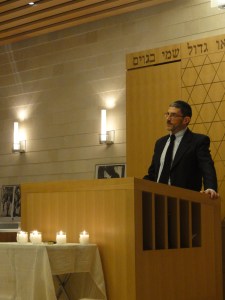The shofar made me cry this year. I was sitting between Ellie and Steve like any good daughter, and the hush of readiness came over the sanctuary. The Rabbi chanted the first “Tekiah” and the shofar’s clarion call rose through the hall and touched the souls of those assembled. Without warning the tears jerked forth from my eyes like a faucet turned up too high, too fast. For centuries Jews have gathered together at this time of year to thank God for the gift of last year, pray for another year of life, confess sins and beg pardon. It’s a part of my life as much as putting on shoes to go out – whether I’m thinking about it or not, being Jewish is part of my identity and heritage.
One of the things I love about being Jewish is the idea of continuity – of belonging. I was hearing that shofar at 11am in Washington DC. At 11am Tokyo time, thirteen hours prior, my husband and children had heard the same call, said the same prayers, heard the same call. My tears, naturally, were for them, mourning that I was not with them to hear it, nor they with me. I have such vivid memories of both of my children’s very first Rosh Hashanahs. I held each of them as babies as the sudden blast of the shofar startled them and I comforted them, whispering the promise of connection they would feel whenever they hear that sound. It connects them to generations past; it connects them to generations in the future. This year we are not connected physically, but with that shofar blast, I could feel them there with me, reminding me that with God’s good help, we will be together next year at this time. And so, the tears.
Ellie and Steve’s synagogue, B’nai Israel in Rockville, is a big place – 1500 member families. I had been there before for various events, so it was mildly familiar with its beautiful wood and stone sanctuary and center area from which the Torah is read. Having grown up in a large, Conservative synagogue, the atmosphere, as well as the liturgy, was familiar. In fact, I’d venture to say that despite its large size, the synagogue was welcoming to me.
The two rabbis of the synagogue welcomed everyone to services, and on erev Rosh Hashanah, (the night before – all Jewish holidays begin at sundown the night before) as well as on both days of Rosh Hashanah, spoke of welcoming – of belonging. Their sermons sounded like they were written for me, aimed at me, spoken in light of my situation. They spoke of gratitude, of making every second count. Rabbi Schnitzer referenced a book by Joan Lunden, saying that people might not remember who won the Pulitzer Prize or the Heisman Trophy, but they do remember the kindness of a friend, the encouragement of a teacher or the touch of a loved one. He gave us the number of seconds in every day and urged us to make every one of those seconds count – every single day. He spoke of a righteous man on his deathbed not saying that life had been good to him, but rather, saying that he was good to the world. Rabbi Safra continued the theme, discussing how God had made the world, but made it to be imperfect, and thus God shows faith in man in his ability to repair the world, and so we are in partnership with God. As we are faithful to God, so is God faithful to us.
Perhaps these sermons seem predictable to you, even proscribed. To me, fighting cancer every day, this entire holiday – indeed this SEASON of holidays – reminds me to be grateful for the people around me, the life that I have, and the self-awareness to be so thankful. Jews around the world are listening to similar sermons, repeating the same exact prayers, and to me it’s a comfort. These ideas and practices were around long before my birth, and will be around long after I’m gone. Continuity.
My Grammy used to say that a human being’s greatest need is to belong. I believe her. At that moment, hearing the shofar in Maryland while sitting between two extra parents, even though I was sad because I wasn’t with my husband and my children, I still belonged. Indeed, it was the community that sustained me and nurtured me to reach this point. Ellie and Steve, my mom and dad, my friends, my family, my doctors – all of them are the community on which I rely for my very existence right now. I am grateful to each person who comprises that community for helping me along this journey. I welcome the year 5774 with a grateful heart – grateful to hear the shofar, and grateful to belong.
G’mar Chatimah Tovah – may you be inscribed for a year of health, love prosperity and peace.











